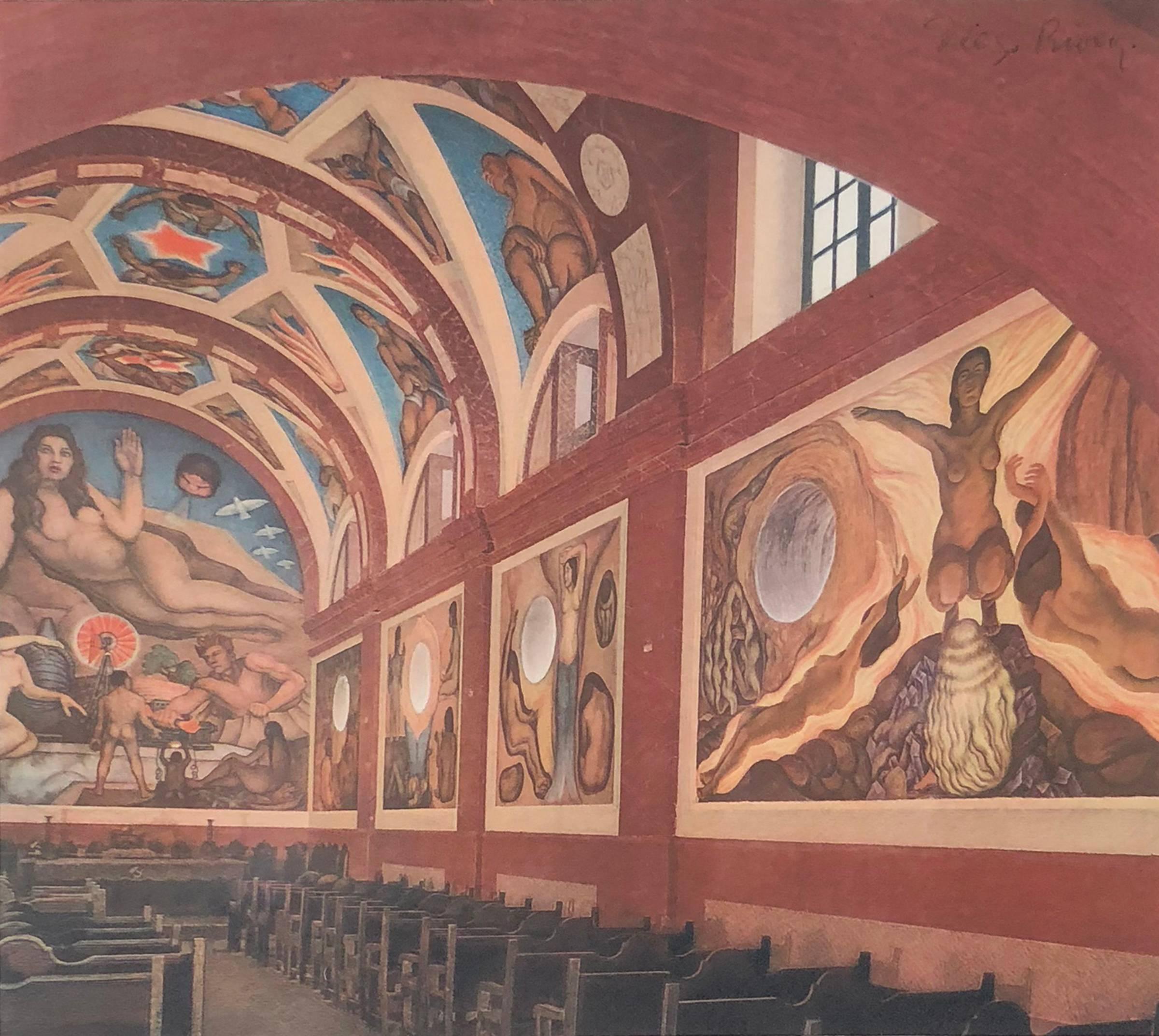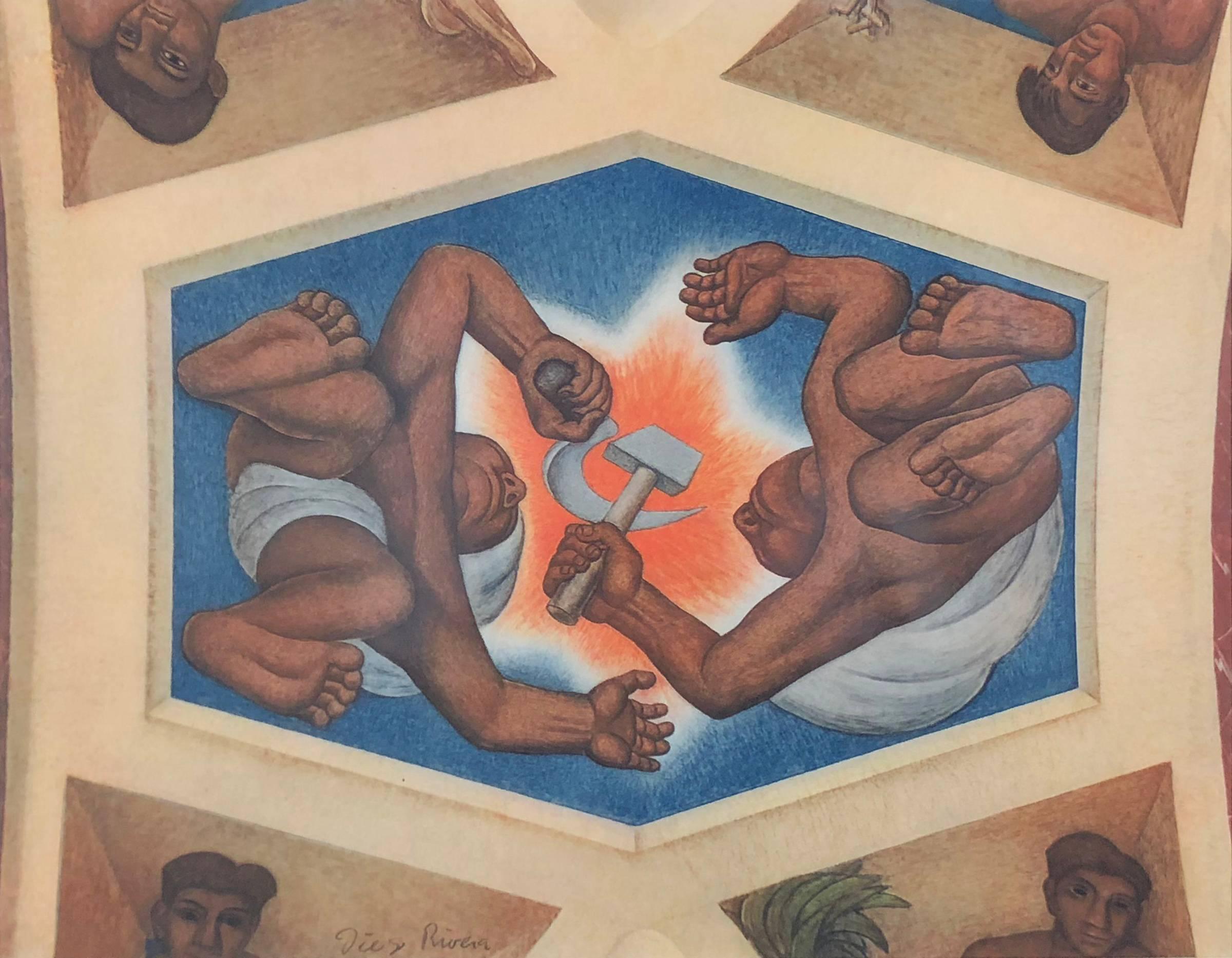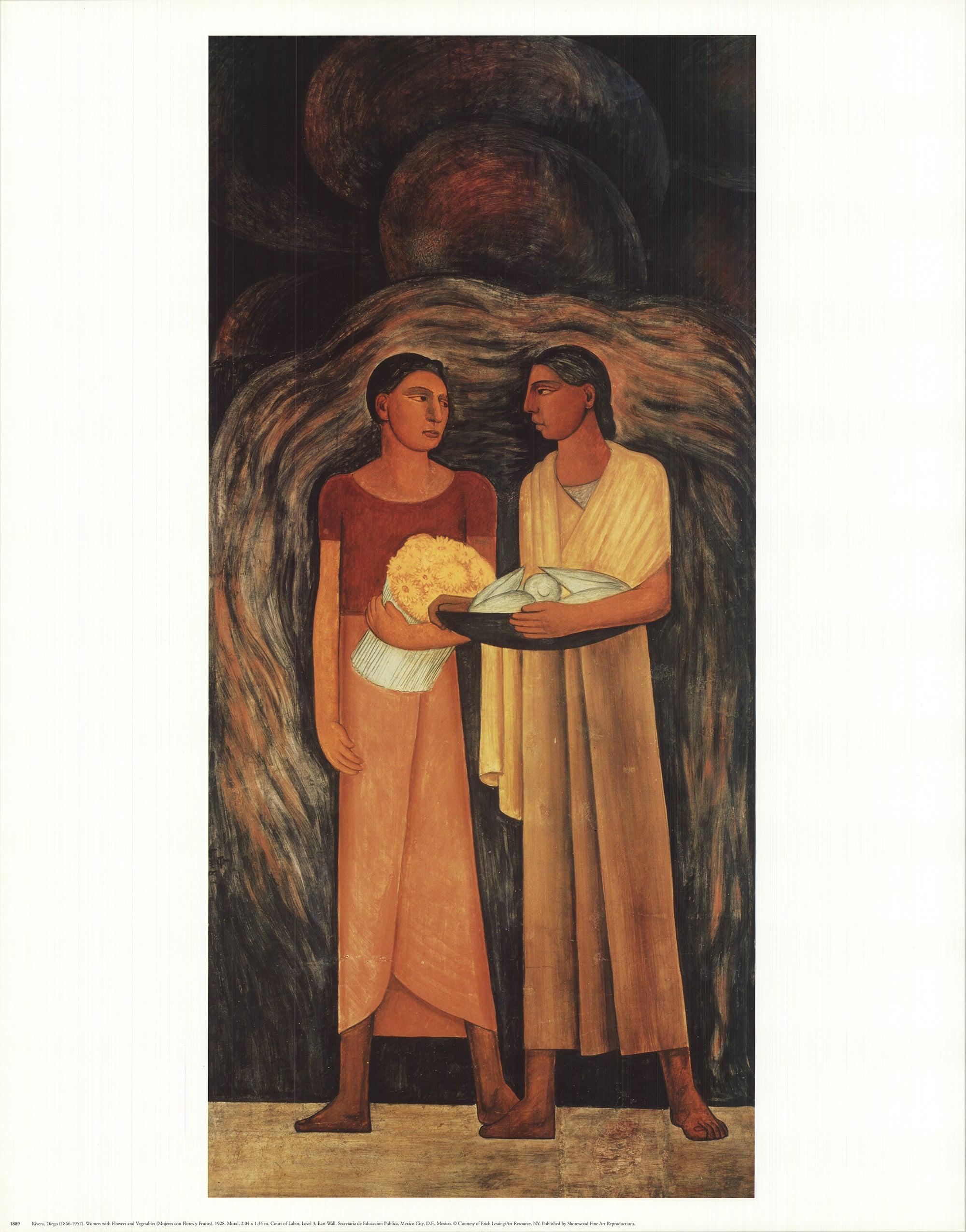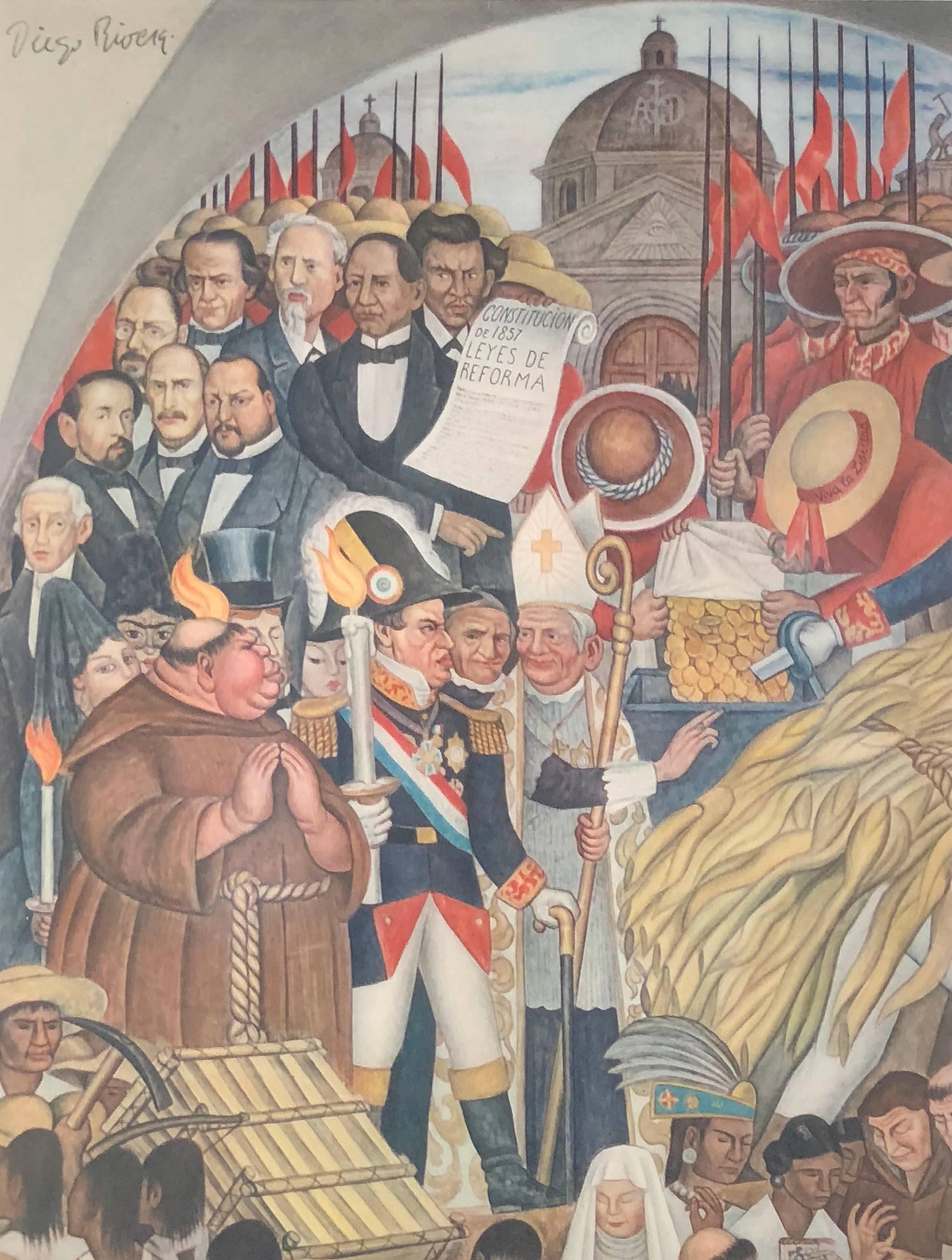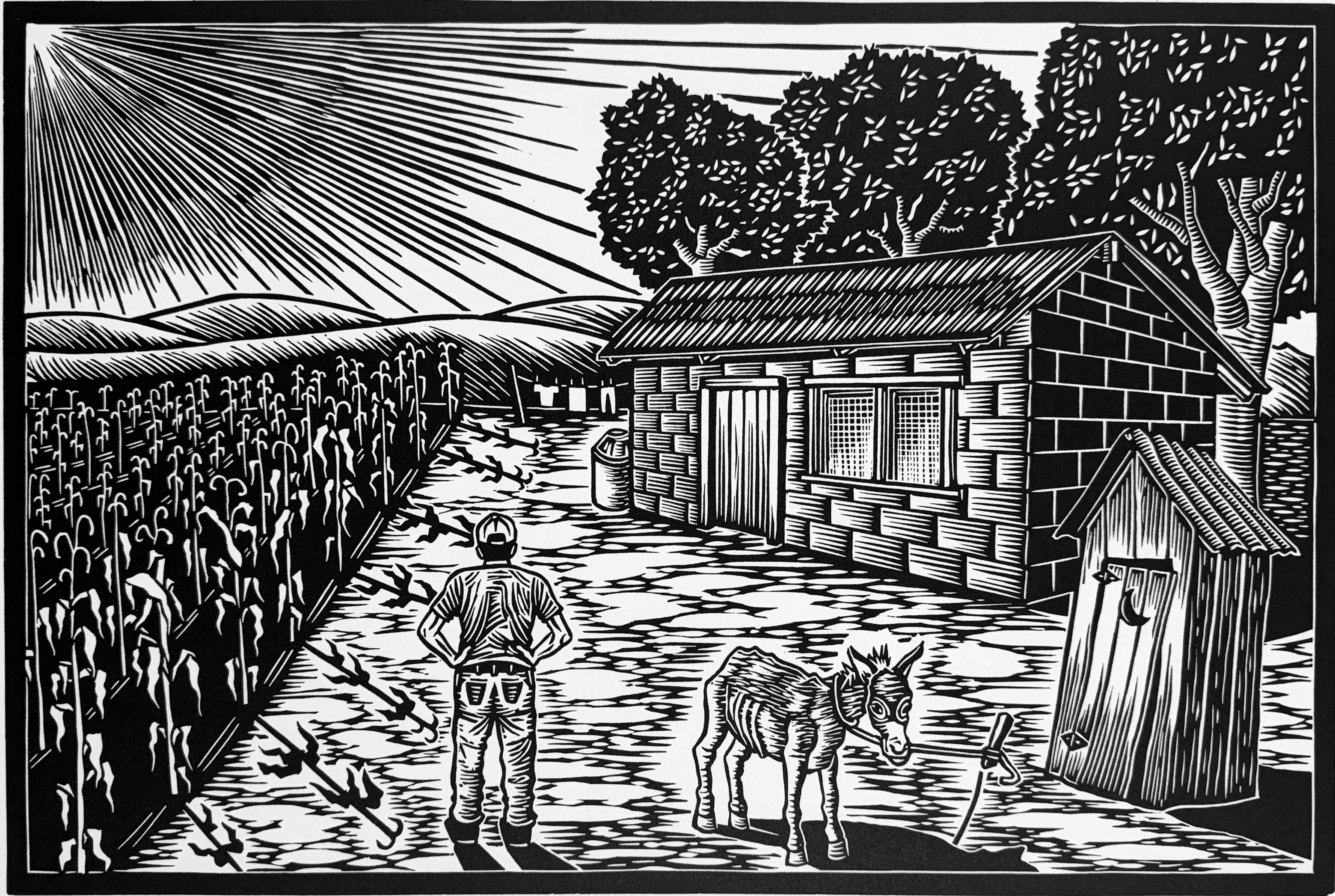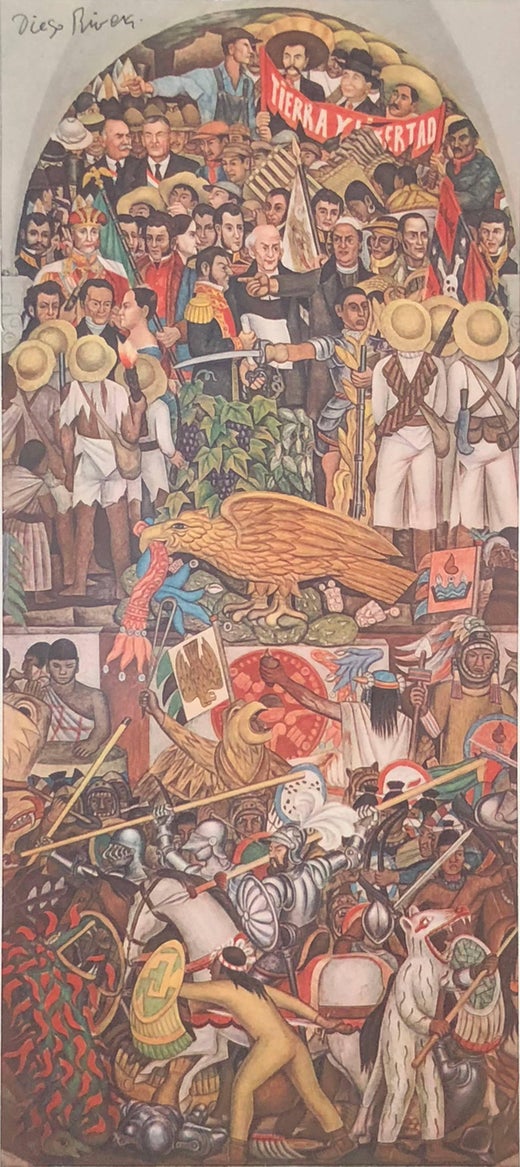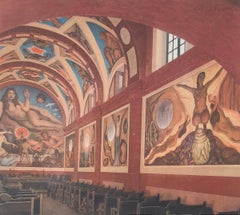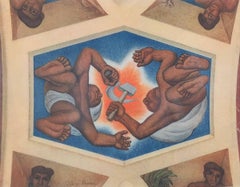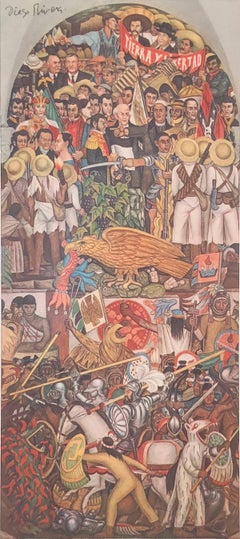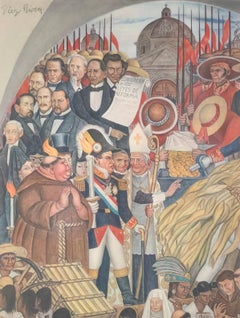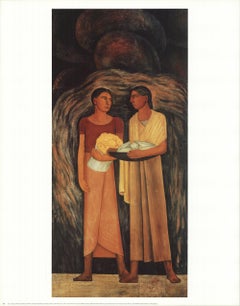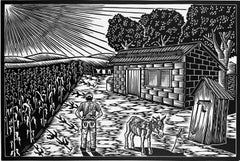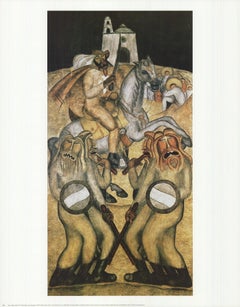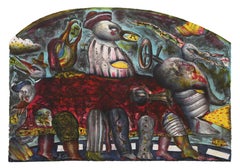Items Similar to Chapel of the Agriculture School, Chapingo (Forces Under the Earth)
Want more images or videos?
Request additional images or videos from the seller
1 of 7
(after) Diego RiveraChapel of the Agriculture School, Chapingo (Forces Under the Earth)1933
1933
$1,500
£1,144.18
€1,303.57
CA$2,108.26
A$2,300.06
CHF 1,217.87
MX$27,561.27
NOK 15,510.22
SEK 14,182.95
DKK 9,733.55
About the Item
(after) Diego Rivera
"Chapel, Agriculture School, Chapingo" (Forces Under the Earth) 1933
from the portfolio "Frescoes of Diego Rivera"
Published by the Museum of Modern Art, NY
Approx. 18.5 x 13.5 with Matting
Hand-Signed by the Artist
Diego Rivera was born on December 13, 1886 in the mountain town of Guanajuato in Mexico. His mother was an ardent Catholic and his father was a rich and aristocratic revolutionary fighter and an atheist. Little Diego decided in favor of atheism. He swore his family had to leave Guanajuato when he was six because of his diatribes against the Church. When he was eleven he attended the San Carlos Academy of Fine Arts; his real teacher was Jose Posada, whose printmaking shop stood near the school.
At the age of twenty he won a traveling scholarship and spent the next three years in
museums and painting in Europe, expressing little of what he felt. In 1910 he returned to Mexico and became involved in the revolution that ended with the forcing out of office the aging dictator Diaz. In 1911 his scholarship was renewed and he sailed for Europe again, this time for a period of ten years. In Paris, he set up housekeeping with a pretty Russian blonde named Angeline Beloff, his first common-law wife; from her he learned the Russian language and from her friends he learned all about Marxism. He also learned about Cubism and Picasso.
A trip to Italy gave him a chance to study Giotto, Uccello and Andrea del Castagno. In 1922 he returned again to Mexico and joined forces with two other revolutionaries, Siqueiros and Orozco. They formed a government-backed syndicate of artists who changed from easel painting to working on murals. In the next decade he did what was probably his greatest work: frescoes in Cuernavaca and in Chapingo, where his favorite model was Guadalupe Marin, a tempestuous olive-skinned beauty. They married and she bore him two daughters. He proved to be a master of figure composition, of space and light, of crowds of farm workers and battle scenes, etc.
In 1927 Rivera decided it was time for a visit of homage to Moscow; he met and sketched Stalin for which he was very honored. Later he did a complete reversal about Stalin. When he got home from Moscow he met and married a pretty art student named Frida Kahlo. They moved into her home in Coyoacan, a Mexico City suburb. Among their many guests was Leon Trotsky who lived with them for two years while he wrote a biography of Stalin, his enemy. Kahlo died in 1954 and not long after, Rivera married again; this time he married Emma Hurtado, a magazine publisher who also had a gallery dealing in Rivera paintings.
Rivera was notorious for his murals in which he openly expressed his opinions on many controversial subjects of the day. The most notorious of these was the one in Rockefeller Center which was reduced to dust by the Rockefeller family after Rivera refused to remove the painting of Lenin uniting the workers. Rivera also worked hard at painting society portraits by the dozen; he did very popular flower paintings, sexy nudes and typical Mexican scenes. He painted the beautiful Dolores Del Rio and Paulette Goddard, the movie actress who posed for him at least twelve times. He made a lot of money which he got rid of as fast as he could make it. He was known as the softest touch in all of Mexico, giving away money to friends, guests and street beggars. He died in Mexico City on November 24, 1957.
- Creator:(after) Diego Rivera (1886 - 1957, Mexican)
- Creation Year:1933
- Dimensions:Height: 13.5 in (34.29 cm)Width: 18.5 in (46.99 cm)
- Medium:
- Movement & Style:
- Period:
- Condition:
- Gallery Location:Missouri, MO
- Reference Number:1stDibs: LU74732826993
(after) Diego Rivera
Diego Rivera was a prominent Mexican painter. His large frescoes helped establish the mural movement in Mexican and international art. Rivera was born as one of the twin boys in Guanajuato, Mexico, to María del Pilar Barrientos and Diego Rivera Acosta, a well-to-do couple. His twin brother Carlos died two years after they were born. They were said to have Converso ancestry. After moving to Paris, Rivera met Angelina Beloff, an artist from the pre-Revolutionary Russian Empire. They married in 1911 and had a son, Diego (1916–1918), who died young. Rivera died in Mexico City on November 24, 1957.
About the Seller
5.0
Vetted Professional Seller
Every seller passes strict standards for authenticity and reliability
Established in 1970
1stDibs seller since 2017
156 sales on 1stDibs
Typical response time: Several days
- ShippingRetrieving quote...Shipping from: Missouri, MO
- Return Policy
More From This Seller
View AllChapel, Agriculture School, Chapingo
By (after) Diego Rivera
Located in Missouri, MO
(after) Diego Rivera
"Chapel, Agriculture School, Chapingo" 1933
from the portfolio "Frescoes of Diego Rivera"
Published by the Museum of Modern Art, NY
Approx. 18.5 x 13.5 with Matting
Hand-Signed by the Artist
Diego Rivera was born on December 13, 1886 in the mountain town of Guanajuato in Mexico. His mother was an ardent Catholic and his father was a rich and aristocratic revolutionary fighter and an atheist. Little Diego decided in favor of atheism. He swore his family had to leave Guanajuato when he was six because of his diatribes against the Church. When he was eleven he attended the San Carlos Academy of Fine Arts; his real teacher was Jose Posada...
Category
1930s Modern Interior Prints
Materials
Lithograph
Chapel of the Agricultural School, Chapingo (Ceiling Detail, Workers)
By (after) Diego Rivera
Located in Missouri, MO
(after) Diego Rivera
"Chapel of the Agricultural School, Chapingo" (Ceiling Detail, Workers) 1933
from the portfolio "Frescoes of Diego Rivera"
Published by the Museum of Modern Art, NY
Size with the Matt: 18.5 x 13.5 inches
Hand-Signed by the Artist
Diego Rivera was born on December 13, 1886 in the mountain town of Guanajuato in Mexico. His mother was an ardent Catholic and his father was a rich and aristocratic revolutionary fighter and an atheist. Little Diego decided in favor of atheism. He swore his family had to leave Guanajuato when he was six because of his diatribes against the Church. When he was eleven he attended the San Carlos Academy of Fine Arts; his real teacher was Jose Posada...
Category
1930s Modern Figurative Prints
Materials
Lithograph
National Palace Mexico City, Persecution of the Indian, Revolution, Independence
By (after) Diego Rivera
Located in Missouri, MO
(after) Diego Rivera
"National Palace Mexico City, Central Stairway" (Persecution of the Indian, Revolution, Independence) 1933
from the portfolio "Frescoes of Diego Rivera"
Published by the Museum of Modern Art, NY
Hand-Signed by the Artist
Diego Rivera was born on December 13, 1886 in the mountain town of Guanajuato in Mexico. His mother was an ardent Catholic and his father was a rich and aristocratic revolutionary fighter and an atheist. Little Diego decided in favor of atheism. He swore his family had to leave Guanajuato when he was six because of his diatribes against the Church. When he was eleven he attended the San Carlos Academy of Fine Arts; his real teacher was Jose Posada...
Category
1930s Realist Figurative Prints
Materials
Lithograph
National Palace, Mexico City (Juarez and the Reform Laws)
By (after) Diego Rivera
Located in Missouri, MO
(after) Diego Rivera
"National Palace, Mexico City (Juarez and the Reform Laws) 1933
from the portfolio "Frescoes of Diego Rivera"
Published by the Museum of Modern Art, NY
Hand-Signed by the Artist
Diego Rivera was born on December 13, 1886 in the mountain town of Guanajuato in Mexico. His mother was an ardent Catholic and his father was a rich and aristocratic revolutionary fighter and an atheist. Little Diego decided in favor of atheism. He swore his family had to leave Guanajuato when he was six because of his diatribes against the Church. When he was eleven he attended the San Carlos Academy of Fine Arts; his real teacher was Jose Posada...
Category
1930s Modern Figurative Prints
Materials
Lithograph
Observador de Pajaros
By Rufino Tamayo
Located in Missouri, MO
"Observador de Pajaros" 1950
By. Rufino Tamayo (Mexican, 1899-1991)
Edition 83/200 Lower Right
Signed Lower Left
Unframed: 15.5" x 22.5"
Framed: 21.75" x 28.25"
Rufino Tamayo (August 26, 1899- June 24, 1991)
A native of Oaxaca in Southern Mexico, Rufino Tamayo's father was a shoemaker, and his mother a seamstress. Some accounts state that he was descended from Zapotec Indians, but he was actually 'mestizo' - of mixed indigenous/European ancestry. (Santa Barbara Museum of Art). He began painting at age 11. Orphaned at the age of 12, Tamayo moved to Mexico City, where he was raised by his maternal aunt who owned a wholesale fruit business.
In 1917, he entered the San Carlos Academy of Fine Arts, but left soon after to pursue independent study. Four years later, Tamayo was appointed the head designer of the department of ethnographic drawings at the National Museum of Archaeology in Mexico City. There he was surrounded by pre-Colombian objects, an aesthetic inspiration that would play a pivotal role in his life. In his own work, Tamayo integrated the forms and tones of pre-Columbian ceramics into his early still lives and portraits of Mexican men and women.
In the early 1920s he also taught art classes in Mexico City's public schools. Despite his involvement in Mexican history, he did not subscribe to the idea of art as nationalistic propaganda. Modern Mexican art at that time was dominated by 'The Three Great Ones' : Diego Rivera, Jose Clemente Orozco, and David Alfaro Siqueros, but Tamayo began to be noted as someone 'new' and different' for his blending of the aesthetics of post Revolutionary Mexico with the vanguard artists of Europe and the United States.
After the Mexican Revolution, he focused on creating his own identity in his work, expressing what he thought was the traditional Mexico, and refusing to follow the political trends of his contemporary artists. This caused some to see him as a 'traitor' to the political cause, and he felt it difficult to freely express himself in his art. As a result, he decided to leave Mexico in 1926 and move to New York, along with his friend, the composer Carlos Chavez. The first exhibition of Tamayo's work in the United States was held at the Weyhe Gallery, New York, in that same year. The show was successful, and Tamayo was praised for his 'authentic' status as a Mexican of 'indigenous heritage', and for his internationally appealing Modernist aesthetic. (Santa Barbara Museum of Art).
Throughout the late thirties and early forties New York's Valentine Gallery gave him shows. For nine years, beginning in 1938, he taught at the Dalton School in New York.
In 1929, some health problems led him to return to Mexico for treatment. While there he took a series of teaching jobs. During this period he became romantically involved with the artist Maria...
Category
20th Century Abstract Abstract Prints
Materials
Lithograph
Price Upon Request
San Miguel, Mexico
By Dong Kingman
Located in Missouri, MO
San Miguel, Mexico
By Dong Kingman (American, 1911-2000)
Unframed: 22" x 15"
Framed: 31" x 24"
Signed Lower Left
Born in Oakland, CA on March 31, 1911. When Kingman was five, his family moved to Hong Kong where he grew up and attended Lingnan Grammar School. The headmaster of the school, Szetu Wei, had studied painting in Paris and recognized his budding artistic talent. For several years he trained young Kingman in both oriental and occidental approaches to painting. Returning to San Francisco in 1929, Kingman became active in the local art scene and began painting scenes of the city. His first solo show at the San Francisco Art Center in 1936 brought immediate recognition. During the 1930s he spent five years working on commissions for the Federal Public Works of Art Project. During WWII he created maps and charts for the O.S.S. After the war Kingman settled in NYC and taught at Columbia University. His paintings were used as backdrops for the movie "Flower Drum Song...
Category
20th Century American Modern Landscape Drawings and Watercolors
Materials
Watercolor
Price Upon Request
You May Also Like
Diego Rivera 'Women with Flowers and Vegetables'- Offset Lithograph
By Diego Rivera
Located in Brooklyn, NY
In "Women with Flowers and Vegetables," Rivera celebrates the resilience and strength of Mexican women, who have historically played a crucial role in sustaining their families and c...
Category
Late 20th Century Prints and Multiples
Materials
Offset
La Cosecha (The Harvest)
Located in Palm Springs, CA
Image size: 18 x 12 inches
Sheet size: 15x22 inches
Edition size: 21
Depicts farm worker contemplating his fields in Mexico.
Dark brown ink on cream-colored 100% archival cotton-r...
Category
2010s Contemporary Landscape Prints
Materials
Screen
Diego Rivera 'Battle Dance' 1995-
By Diego Rivera
Located in Brooklyn, NY
The poster for Battle Dance by Diego Rivera captures the dynamic energy of his mural style, depicting powerful, muscular indigenous dancers in rhythmic movement that blends ritual an...
Category
1990s Prints and Multiples
Materials
Offset
$72 Sale Price
20% Off
Autobus, Surrealist Lithograph by Alejandro Colunga
By Alejandro Colunga
Located in Long Island City, NY
Artist: Alejandro Colunga, Mexican (1948 - )
Title: Autobus
Year: 1979
Medium: Lithograph on Arches, signed and numbered in pencil
Edition: 110
Size: 25 x 36 in. (63.5 x 91.44 cm)
Category
1980s Surrealist Figurative Prints
Materials
Lithograph
1920s Gelatin Silver Print by Tina Modotti of a Diego Rivera Fresco
By Tina Modotti
Located in Chicago, IL
An original 1920s gelatin silver print by famed photographer Tina Modotti, depicting a mural fresco by Diego Rivera in the Secretariat of Education in Mexico City, Mexico. Photo is ...
Category
1920s Modern Black and White Photography
Materials
Silver Gelatin, Paper
Diego Rivera 'Indigenous Woman with Corn Stalks' 1999- Offset Lithograph
By Diego Rivera
Located in Brooklyn, NY
Published and distributed by New York Graphic Society
Paper Size: 36 x 19.5 inches ( 91.44 x 49.53 cm )
Image Size: 31 x 15.5 inches ( 78.74 x 39.37 cm )
Framed: No
Condition: B: V...
Category
1990s Prints and Multiples
Materials
Offset
$72 Sale Price
20% Off
More Ways To Browse
Salvador Dali Litho
Salvador Dali Lobster
Salvador Dali Mao
Salvador Dali Melting Clock
Salvador Dali Pig
Salvador Dali Shakespeare
Salvador Dali Woman With A Whip
Sascha Schneider
Sean Caulfield
Sebastien Leclerc
Shabbat Shalom
Shag Agle
Shalom Moskowitz Shalom Of Safed
Shepard Fairey Oil
Spoleto Poster
Stag Salvador Dali
Suffering Moses
Sufi Art
